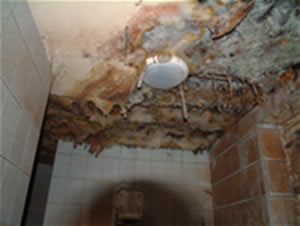| |
Dry Rot, serpula lacrymans
Timber may be attacked by many species of wood-rotting fungi, the most widespread in Britain being the True Dry
Rot Fungus, Serpula lacrymans. When spores from this fungi settle on damp wood they germinate and develop fine,
thread-like filaments called hyphae. Each hypha releases enzymes, which break down wood cells, causing loss of
timber strength. Fungi cannot attack wood at or below about 20% moisture content so decay does not occur unless
dampness in buildings arises through poor design or building faults.
 
"Dry rot" is the term used for decay caused by Serpula lacrymans, the True Dry Rot Fungus. It is a brown rot
that destroys the cellulose component of wood, eventually reducing timber to a dry and crumbly consistency - hence
the name 'dry rot'
Dry rot is the most serious type of timber decay in buildings because it can cause rot at a lower moisture content
than wet rot fungi and it has the ability to grow through damp masonry and brickwork, and behind plaster. It can
therefore spread rapidly through a building, making treatment both complicated and expensive.
Dry rot has been a problem in wooden structures for centuries, with some of the earliest documented accounts
coming from the Royal Navy of James I in the early seventeenth century. Since then it has moved on from ships to
buildings and is now found throughout Britain. It is most prevalent in the north and west of the country and in
buildings constructed before the Second World War.
Warning signs
- Rust/dark orange coloured spore dust around
Sporophore
- Spore dust may also be evident at bleed areas such as gaps under
skirting boards or in areas with no carpet such as understair cupboards
- Strong smell of mushrooms around the fungi
- White mycelium, can be similar to heavy spiders web or white pillows
of cotton wool, depending on humidity
- Gray white coloured hyphae (may look like a vine with no
leaves)
- Timber is scarred with deep cracks across the
grain, becomes light in weight and crumbles easily between fingers.
If you are an accomplished DIYer or have a good local joiner you can
call on, you could tackle most rot problems with the advice and resources in our guide Dealing with Wood rot
I would however recommend contacting a specialist company with a fully reliable guarantee to carry out any
eradication work for Dry Rot. Dry Rot has a nasty habit of returning if even the slightest trace is left behind
following treatment. Professionals can have problems with this fungi and I personally would not be happy trusting a
smaller outfit to return time after time, free of charge if the problem persists. If you have, or suspect you have
dry rot, click to request a Free Inspection

|
|
|
Advertise on this
page
Place an advert for your Business on this highly targeted High traffic
page
Contact
www.DavisonInternet.co.uk
For
details
|
|
Specialist Contractors in
Newcastle upon Tyne
& surrounding areas
 |
Damp |
 |
Condensation |
 |
Wet Rot |
 |
Dry Rot |
 |
Woodworm |
 |
Basement
Conversions |
 |
Cellars |
Dryspace Maintain
0191 2308029
www.DryspaceMaintain.com
|
|
|
|



